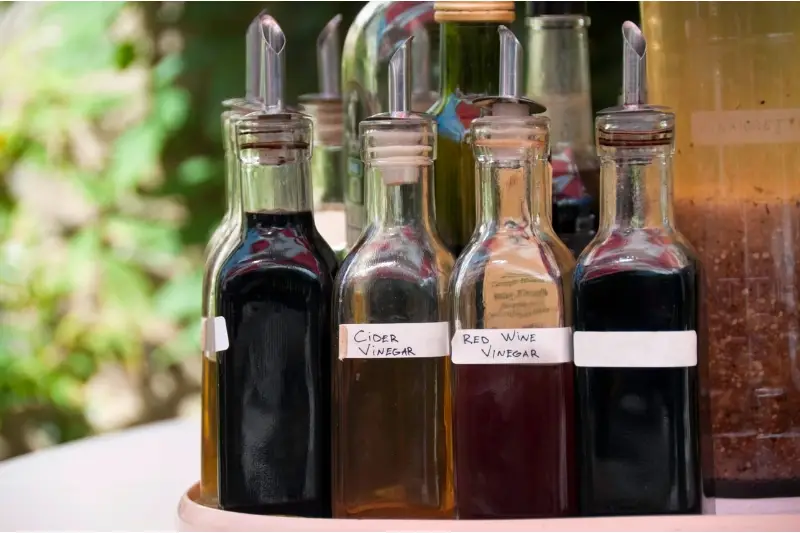Pickling has been used for thousands of years as a way to preserve food, and it’s still popular today.
Pickled vegetables can add flavor to sandwiches, salads, and more, and they’re also a great way to use up extra produce from your garden or farmers’ market.
However, not all vinegars are created equal when it comes to pickling.
This article will help you pick the best vinegar for your pickling needs.
 Pickling Vinegar:” class=”wp-image-2321″/>
Pickling Vinegar:” class=”wp-image-2321″/>What is Pickling Vinegar?
Pickling vinegar is a type of vinegar that is specifically designed for use in pickling. It typically has a higher acidity than regular vinegar, which helps preserve the vegetables or fruit being pickled. Pickling vinegar also has a more neutral flavor than other vinegars, which allows the flavors of the spices and vegetables to shine through.
What Makes a Good Pickling Vinegar?
When choosing a vinegar for pickling, there are a few key factors to consider:
- Acidity: A good pickling vinegar should have an acidity of at least 5%. This is important for preserving the vegetables and preventing the growth of harmful bacteria.
- Flavor: While pickling vinegar should have a neutral flavor, it should also complement the flavors of the vegetables or fruit being pickled.
- Color: Depending on the recipe, the color of the vinegar may be important. For example, if you’re pickling beets, you may want to use a white vinegar to preserve their vibrant color.
Types of Vinegar for Pickling
There are several types of vinegar that can be used for pickling, each with its own unique flavor and characteristics.
White Vinegar
White vinegar is the most commonly used vinegar for pickling. It has a high acidity level and a neutral flavor, which makes it a good choice for most pickling recipes. White vinegar is also inexpensive and widely available.
Apple Cider Vinegar
Apple cider vinegar has a slightly sweet flavor that can complement the flavors of certain fruits and vegetables. It also has a lower acidity than white vinegar, which can be desirable in some recipes.
Malt Vinegar
Malt vinegar is made from malted barley and has a distinct, slightly sweet flavor. It’s commonly used in British-style pickles, such as pickled onions and gherkins.
Rice Vinegar
Rice vinegar is commonly used in Asian-style pickles, such as pickled ginger and daikon radish. It has a milder flavor than other vinegars and can be made from either rice wine or rice.
Wine Vinegar
Wine vinegar is made from red or white wine and has a slightly fruity flavor. It’s a good choice for pickling fruits, such as peaches and plums.
Balsamic Vinegar
Balsamic vinegar has a complex, sweet flavor that can add depth to pickled vegetables. However, it’s not recommended for use in most pickling recipes due to its high cost and strong flavor.
How to Choose the Best Pickling Vinegar
When choosing a vinegar for pickling, consider the following factors:
- Acidity level: Make sure the vinegar has at least 5% acidity.
- Flavor: Choose a vinegar that complements the flavors of the vegetables or fruit being pickled.
- Color: Consider the color of the vinegar if it’s important to the recipe.
- Cost: White vinegar is typically the most affordable option, but higher-end vinegars can add unique flavors to your pickles.
Tips for Using Pickling Vinegar
Here are a few tips to keep in mind when using pickling vinegar:
- Always follow the recipe: Pickling is a science, so it’s important to follow the recipe closely to ensure the right balance of acidity and flavor.
- Use non-reactive containers: Use glass, ceramic, or stainless steel containers when pickling, as reactive materials like aluminum can affect the flavor of the pickles.
- Let the pickles sit: Pickles need time to absorb the flavors of the vinegar and spices, so don’t rush the process. Most pickles need at least a week to develop their full flavor.
- Store the pickles properly: Once the pickles are ready, store them in the fridge to prevent spoilage.
Conclusion
Choosing the right vinegar is an important part of the pickling process. By considering factors like acidity, flavor, and color, you can choose the best vinegar for your pickling recipe. Whether you prefer classic white vinegar or want to experiment with more exotic options, there’s a pickling vinegar out there for everyone.
FAQs
- Can I use regular vinegar for pickling? Regular vinegar can be used for pickling, but it may not have the right level of acidity or flavor for optimal results. It’s best to use a vinegar specifically designed for pickling.
- What’s the difference between pickling vinegar and regular vinegar? Pickling vinegar has a higher acidity level than regular vinegar, which is important for preserving the vegetables or fruit being pickled. It also has a more neutral flavor than other vinegars, which allows the flavors of the spices and vegetables to shine through.
- Can I use flavored vinegar for pickling? Flavored vinegar can be used for pickling, but keep in mind that it may affect the flavor of the pickles. It’s best to use a vinegar with a neutral flavor to let the pickling spices and vegetables shine through.
- Can I reuse pickling vinegar? Pickling vinegar can be reused, but it may lose some of its acidity and flavor after the first use. It’s best to use fresh vinegar for each batch of pickles.
- Can I pickle without vinegar? Yes, there are alternative methods of pickling that use other acidic liquids, such as lemon juice or whey. However, these methods may produce different results than traditional vinegar-based pickling.
